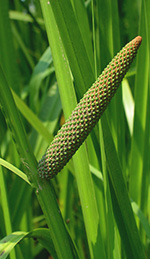Calendula…even the name is soothing and speaks of the fragrant warmth of this lovely and underappreciated essential oil! Steam distilled from the golden yellow or orange petals of the Old World marigold, calendula essential oil is a renowned skin salve that may be especially helpful in controlling the symptoms of psoriasis and other related skin diseases [1]. The oil is a clinically recognized anti-inflammatory [2], and also has cicatrizant, antioxidant, antimicrobial, and vulnerary (wound-healing) properties [2]. One study has even suggested that calendula oil might have anti-tumoral actions as well [2]!
The common name “calendula” comes from the Latin calendulae—a diminutive of the Latin for calendar. Calendulae means something like “little calendar”, “little clock”, or “little hourglass”, perhaps a reference to the way calendula’s bright orange or yellow blossoms follow the passage of the sun across the sky. There are several marigold species with the genus name Calendula, all of them found in the daisy family Asteraceae. These species are native to Western Europe, the Mediterranean, Southwest Asia and Macronesia. The species used to produce an essential oil is Calendula officinalis. The plant itself has a woody purple stem, serrated green leaves, and a round yellow or orange daisy-like flower [3]. The oil can be distilled from the flower or leaf, both of which yield a range of mostly sesquiterpenoid compounds such as T-muurolol, a-thujene, d-cadinene, b-pinene, 1,8-cineol, and y-terpene [4].
Calendula flowers were a common food additive, medicine, and even ceremonial decoration in the Near East and Mediterranean world: the dried petals were added to butter and cheese as colorants, used to flavor stews, and powdered as a saffron substitute when that costly spice was unattainable. The practice of flavoring stews with calendula led to its other common name, “pot marigold”! The Greeks and Romans sometimes wore garlands of calendula flowers during ceremonial occasions, similar to the ceremonial use of bay laurel crowns, and calendula blossoms were used as far away as India to adorn Hindu deities. The vivid oranges and yellows of calendula flowers could also be processed into a yellow dye used in making paint. Today, the flowers have also found a place in the varnish, nylon and cosmetics industries [4].
Traditional medicine recognized calendula’s usefulness for treating digestive disorders such as indigestion, constipation, and abdominal cramps [5]. Modern tests on rabbit small intestine using an aqueous extract of calendula flowers discovered that the extract exhibited both spasmolytic and spasmogenic effects, which could explain this medicinal use [5]. The fresh flowers were also used in poultices to stop bleeding, speed healing, and prevent wounds from getting infected [3]; calendula was still being used antiseptically on battlefields during the Civil War and World War I.
Today, the most popular use for calendula essential oil is in treating the irritation and outbreaks associated with dermatitis and psoriasis [1]. Psoriasis sufferers in particular might consider using an infusion of calendula oil in a carrier oil to give relief to their symptoms. Psoriasis is an uncomfortable skin disease in which inflamed lesions form on the skin, covered by a white or silvery scale. The condition is most common in Caucasian women and least common in people of color.
Apart from being unsightly and embarrassing for the afflicted person, psoriasis can result in serious health complications if left untreated—particularly opportunistic infections resulting from damaged skin integrity caused by scratching the itchy lesions. An infusion of calendula essential oil can greatly lessen the irritation and inflammation caused by psoriasis, while its antiseptic qualities combat infections before they can begin [1]. Calendula oil infusions are very easy to use: simply buy a readymade infusion or make your own by adding a few drops of calendula essential oil to 1 fluid ounce of olive, almond, or another gentle carrier oil. Then apply a few drops of the infusion to any irritated skin one to two times a day, preferably after a soothing, skin-softening warm bath.
REFERENCES
1. “Calendula Oil for Healthier Skin”. The Aromatherapy Spot. Accessed July 29th, 2014. http://www.aromatherapy-spot.com/aromatherapy-essential-oils/calendula-essential-oil.shtml.
2. Jimenez-Medina E, Garcia-Lora A, Paco L, Algarra I, Collado A, Garrido F (2006). “A new extract of the plant Calendula officinalis produces a dual in vitro effect: cytotoxic anti-tumor activity and lymphocyte activation”. BMC Cancer 6: 119.
3. “Calendula”. Wikipedia. Last modified July 19th, 2014.
http://en.wikipedia.org/wiki/Calendula.
4. Okoh, O., AP Sadimenko, OT Asekun, and AJ Afolayan. May 16th, 2008. “The Effects of Drying on the Chemical Components of Essential Oils of Calendula officinalis L.” African Journal of Biotechnology 7 (10): 1500-1502.
5. Bashir, S, KH Janbaz, Q Jabeen et al. 2006. “Studies on spasmogenic and spasmolytic activities of Calendula officinalis flowers”. Phytotherapy Research 20: 906-910.

 The practice of ingesting essential oils is one of the more contentious issues in aromatherapy. Ask a dozen different aromatherapists and you’re likely to get a dozen different answers as to the efficacy and safety of taking essential oils internally.
The practice of ingesting essential oils is one of the more contentious issues in aromatherapy. Ask a dozen different aromatherapists and you’re likely to get a dozen different answers as to the efficacy and safety of taking essential oils internally.







